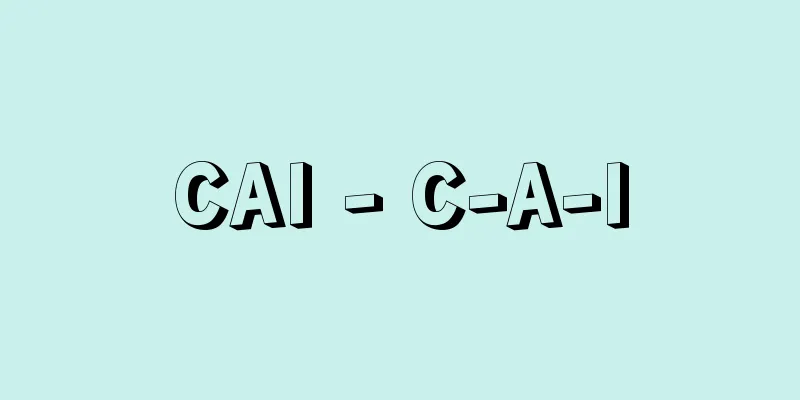CAI - C-A-I

|
Education based on the idea of individualized learning, in which the activities of learners and instructors are carried out effectively and efficiently using computer-based devices. Such an environment is called a CAI system. Unlike CMI, which uses computers for the management and administration of educational administration and educational information, CAI refers to one form of using computers in subject education. CAI and CMI are also different from "information education," which refers to education about computers and information and was introduced in the curriculum guidelines announced in 1989 (Heisei 1). In "information education," computers, information, and related matters are treated as educational content. CAI is an abbreviation for Computer Assisted Instruction, with Aided sometimes used instead of Assisted. It literally means "instruction assisted by a computer." Instead of Instruction, the word "Learning" is used, particularly in Europe, and it is sometimes abbreviated as CAL. CAI is based on the development of programmed learning, teaching machines, behavioral science, cognitive science, information science, and other fields. With the spread of today's high-speed lines, video compression technology, and related interfaces and high-quality database technology, it is also a system that has formed the basis and foundation of e-learning, which is being introduced in training institutions and higher education institutions. [Shinohara Fuyoji] significanceThe teaching and learning process is a series of events in which teachers and students interact with each other toward an educational goal. CAI systems attempt to entrust many of the teacher's interactions to the processing power of computers. They are also an attempt to integrate research and practice on the content and methods of education, and to make education more scientific. [Shinohara Fuyoji] History of developmentThe history of CAI systems began with research by IBM in the United States, which began in 1958 and was completed in 1960. Later, with the expansion of computer functions and the development of research in teaching theory, learning theory, and evaluation theory, a series of systems were developed, including the PLATO system (1960) at the University of Illinois and the TICCIT system (1969) at Brigham Young University. Research also progressed in Japan in the 1960s, and a time-sharing system (TSS) using large and medium-sized computers was developed. However, it did not become widespread due to the high price of the computers themselves and the fact that the theories and practices mentioned above had not yet been fully absorbed in the Japanese educational field. In the 1980s, the emergence of personal computers, their improved functionality, and the fall in prices brought about an awareness of using CAI in educational practice, building on the accumulated research to date. From the 1980s to the early 1990s, research on natural language CAI using flexible human speech, optimization teaching model CAI based on an optimization model of learning, artificial intelligence CAI, database CAI, and other systems became popular, contributing to the advancement of research into human learning and information processing, that is, cognitive structure. Many of the results of this research and practical use were used as basic research into education using information and communication networks such as the Internet, known as Web learning and e-learning, which began in the late 1990s, and further raised awareness of the importance of CAI. [Shinohara Fuyoji] Current situation and issuesCAI so far includes "problem-solving learning," "game/simulation learning," "inquiry learning (information search type)," "individual learning," and "drill learning," and is positioned as the foundation of e-learning. However, the educational use of CAI using personal computers in school education has been mostly simulation learning for demonstrations, such as the proof of movement in finding the area of a parallelogram or trapezoid, or the movement of celestial bodies, which are difficult to observe in daytime classroom lessons, in mathematics and science education, and drill learning to improve the accuracy and speed of skills, but there is little individual learning CAI aimed at concept formation in the lecture format that accounts for the majority of class activities in school education. On the other hand, personal computers have already been introduced in schools, and the environment is in place to use them to "establish and enrich the basics" of subject education, and high-quality software is available on the market to encourage their use, especially in lower grades. In 1989, 1998 and 1999, the Course of Study, which showed "New View of Academic Ability" and "Zest for Living", was announced, and the Course of Study for 2008 and 2009 was announced based on the purpose of further enhancing and developing them. In these, CAI systems are being used for "expressive ability" and "judgment and thinking ability", which are important new educational goals. However, unless we can answer many basic questions related to pedagogy, teaching methodology and the developmental stage of children's minds and bodies, such as what is the role of school education in the new era and what is the role of teachers, not only CAI but also various media will make the same mistakes as the introduction of audiovisual teaching materials and equipment in the past. We must avoid the concentration of work on a few teachers and instructors and the obstruction of healthy development of the minds and bodies of young people, including children and students, due to the media that were supposed to be introduced to realize school education that corresponds to the globalized society and rich learning in a lifelong learning society. [Shinohara Fuyoji] "New Developments in Educational Technology," edited by the Committee for the Publication of Research Results in Educational Technology (1977, Daiichi Hoki Publishing)" ▽ "On the Use of Microcomputers in Education -- Report," written by the Educational Broadcasting Subcommittee of the Council for Social Education (1985, Ministry of Education)" ▽ "Summary of the First Discussion of the Research and Study Collaborators' Conference on the Form of Primary and Secondary Education in Response to the Information Society," written by the Elementary and Secondary Education Bureau, Ministry of Education (1985, Ministry of Education)" ▽ "Learning: Hidden Treasure -- Report of the UNESCO International Committee on Education for the 21st Century," edited by Amagi Isao (1997, Gyosei)" ▽ "New Developments in Audiovisual Education," edited by Nozu Yoshio, 2nd edition (1998, Toshin-do)" ▽ "Computers Are Changing Children's Minds," written by Jane Hurley, translated by Nishimura Kensaku and Yamada Shizuo (1999, Taishukan Shoten)" ▽ "Learning Web Project: Digital Revolution in Learning - A Cutting-Edge Educational Information Technology Project to Pave the Way for Learning in the 21st Century" edited by Information-Technology Promotion Agency (IPA) (2000, Gakken) " "Saeki Osamu, New Computers and Education (Iwanami Shinsho)" "Jack A. Chambers et al. Computer Assisted Instruction; Its Use in the Classroom (1983, Prentice Hall, New York)" [Reference items] | | | | | | | |Source: Shogakukan Encyclopedia Nipponica About Encyclopedia Nipponica Information | Legend |
|
学習者および教授者の活動を、コンピュータを中心とする機器によって効果的かつ効率的に進める、個別学習の考え方に基づく教育。そのように整備された環境をCAIシステムという。コンピュータを教育経営や教育情報などの管理運営に活用するCMIとは異なり、コンピュータを教科教育で活用する一つの態様をさす。CAIとCMIは、1989年(平成1)に告示された学習指導要領で導入された、コンピュータや情報に関する教育を意味する「情報教育」とも異なる。「情報教育」ではコンピュータや情報および関連する事項が教育内容として扱われる。 CAIは、コンピュータ・アシステッド・インストラクションComputer Assisted Instructionの略で、AssistedのかわりにAidedが使われることもある。文字どおりには「コンピュータに援助された教授」である。「教授」を意味するInstructionのかわりに、とくにヨーロッパでは、「学習」を意味するLearningを用い、CALと略されることもある。CAIはプログラム学習、ティーチング・マシン、行動科学、認知科学、情報科学等の発展のうえに成り立っている。今日の高速回線と映像の圧縮技術、および関連するインターフェースや品質の高いデータベース技術の普及によって、訓練機関や高等教育機関で導入されつつあるeラーニングの基礎と基本を形成したシステムでもある。 [篠原文陽児] 意義教授・学習の過程は、教育目標に向けて教師と学習者が働きかけ合うという事象の連続である。CAIシステムはこの事象のうち、教師の働きかけの多くをコンピュータの処理能力にゆだねようとするものである。そして、教育の内容と方法等にかかわる研究と実践とを統合し、教育をより科学化する試みの一つである。 [篠原文陽児] 発展の沿革CAIシステムの歴史は、アメリカでのIBM社の研究に始まり、1958年に開始され、1960年に完成した。その後、コンピュータの機能の拡充と、教授理論・学習理論、また評価理論等々の研究の発展に伴って、イリノイ大学のPLATO(プラトー)システム(1960)、ブリンガムヤング大学のTICCIT(ティキット)システム(1969)などが次々と開発された。日本でも、1960年代に研究が進められ、大型計算機や中型計算機を使ったタイムシェアリング方式(TSS)によるシステムが開発された。しかし、コンピュータそのものの価格が高いこと、そして先に述べた諸理論等や実践が日本の教育の現場ではまだ十分に消化されていなかったなどの事由によって、広く普及するまでには至らなかった。 1980年代になって、パーソナルコンピュータの出現と機能の充実、そして価格の低下が、これまでの研究の蓄積のうえに、CAIを教育実践の場で活用しようという意識をもたらした。1980年代から1990年代初頭にかけては、人間の柔軟な話しことばによる自然言語CAI、学習の最適化モデルに基づく最適化教授モデルCAI、人工知能型CAI、データベース型CAIなどの研究が盛んとなり、人間の学習や情報の処理のしかた、つまり認知構造の研究の進展に寄与した。こうした研究と実践的利用による成果の多くは、1990年代後半から始まったWebラーニングやeラーニングとよばれるインターネットなど情報通信ネットワークを用いた教育の基礎研究として活用され、CAIの重要性をますます認識させることになった。 [篠原文陽児] 現状と課題これまでのCAIには、「問題解決学習」「ゲーム・シミュレーション学習」「問い合わせ学習(情報検索型)」「個別学習」「ドリル学習」などがあり、eラーニングの基礎・基本として位置づけられている。しかし、学校教育におけるパーソナルコンピュータを活用したCAIの教育利用は、数学・理科教育における、平行四辺形や台形の面積の求め方にみられるような動きを与えた証明や、天体の運動などのような、日中の教室授業では観察などがむずかしい事象の指導に代表される演示用シミュレーション学習、技能の正確性、迅速性を高めるドリル学習が多く、学校教育の授業活動の大部分を占める講義形式による概念形成を目的とするような、個別学習のCAIは少ない。一方すでにパソコンが学校に導入され、教科教育の「基礎・基本の定着と充実」に活用される環境は整って、とくに低学年での活用を促す質の高いソフトウェアが市販などされている。 1989年(平成1)、1998年および1999年には「新しい学力観」や「生きる力」が示された学習指導要領が告示され、それらをいっそう充実し展開させる趣旨に基づいて、2008年と2009年の学習指導要領が告示された。そのなかで、新たな教育目標として重要な「表現力」と「判断力・思考力」に、CAIシステムが活用されるようになっている。ただし、新たな時代に対応する学校教育の役割とは何か、教師の役割とは何か等々、教育学や教育方法学および子供の心身の発達段階に関係する多くの基本的な問いに答えられなければ、CAIのみならず多様なメディアは、これまでの視聴覚教材・機材の導入にみられたと同じ轍(てつ)を踏むことになろう。グローバル化社会に対応する学校教育や、生涯学習社会における豊かな学習を実現するために導入したはずのメディアによって、一部の教師や指導者に業務が集中したり、児童・生徒をはじめとする青少年の心身の健全な発達が阻害されたりすることは避けねばならない。 [篠原文陽児] 『教育工学研究成果刊行委員会編『教育工学の新しい展開』(1977・第一法規出版)』▽『社会教育審議会教育放送分科会著『教育におけるマイクロコンピュータの利用について――報告』(1985・文部省)』▽『文部省初等中等局著『情報社会に対応する初等中等教育の在り方に関する調査研究協力者会議第一次審議とりまとめ』(1985・文部省)』▽『ユネスコ「21世紀教育国際委員会」編、天城勲監訳『学習:秘められた宝――ユネスコ「21世紀教育国際委員会」報告書』(1997・ぎょうせい)』▽『野津良夫編『視聴覚教育の新しい展開』第2版(1998・東信堂)』▽『ジェーン・ハーリー著、西村辧作・山田詩津夫訳『コンピュータが子どもの心を変える』(1999・大修館書店)』▽『情報処理振興事業協会(IPA)編『Learning Web Project 学びのデジタル革命――21世紀の学びを拓く最先端の教育の情報化プロジェクト』(2000・学習研究社)』▽『佐伯胖著『新・コンピュータと教育』(岩波新書)』▽『Jack A. Chambers et al.Computer Assisted Instruction;Its Use in the Classroom (1983, Prentice Hall, New York)』 [参照項目] | | | | | | | |出典 小学館 日本大百科全書(ニッポニカ)日本大百科全書(ニッポニカ)について 情報 | 凡例 |
Recommend
Electric resistor - denki teikouki (English spelling) resistor
Resistors are also called resistors. They are devi...
Narai
A post town on the Nakasen Road in Chikuma County,...
Kisfaludy Károly
Born: February 5, 1788 Tet [Died] November 21, 183...
Burne-Jones (English spelling) Edward Coley Burne-Jones
1833‐98 British painter and decorator. Born in Bir...
Metellus Numidicus, QC (English notation) Metellus NumidicusQC
…Early in the war, a peace treaty was concluded w...
children's apperception test
…Murray's interpretation is based on his dema...
Jabal al-Nabī Shu'ayb (mountain)
Located in the Bani Matar district of Sana'a p...
Beza, T. (English spelling) BezaT
…French humanist and religious reformer. Latin na...
Code of the Alemanni - Code of the Alemanni
...Law of Germanic tribes in the early Middle Age...
Illusion - Illusion
…However, if there are many taxation preferential...
Ball crown - Kyukan
The part of a sphere cut by a plane that intersect...
Ripl-Flo screen
...The sieve frame is either suspended using a sp...
Blacksmith - Kajiya
A craftsman who forges metal. Also called a black...
Iwashobu - Iwashobu
A perennial herb of the lily family (APG classifi...
loose barn
...If the enclosure is small, it is called a pen ...









